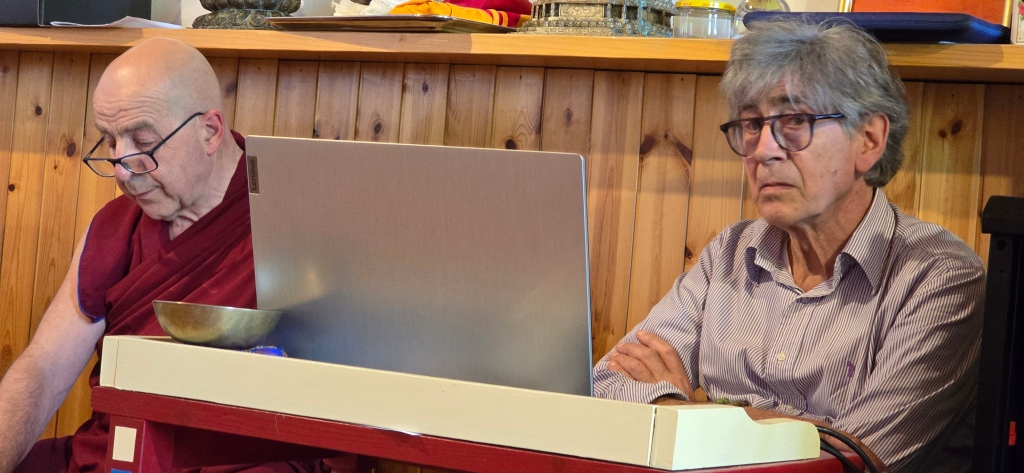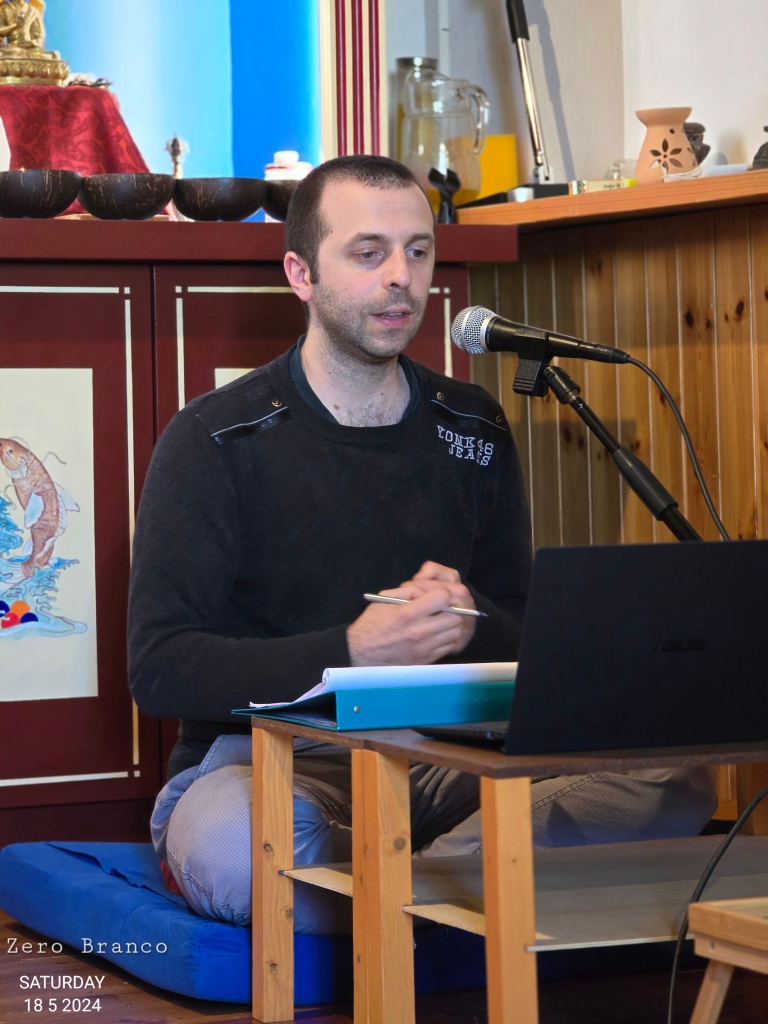A Little Story, a Cozy Town and a Most Wonderful Teaching
A trip. Mid-May, I had the great joy of being able to attend one of the teachings of my spiritual Master, Geshe Jampa Gelek, in Treviso, Italy. It has been a most noble time, spent in this beautiful Italian city, and I am grateful for every hour spent there.
I reached on Friday morning, and since I had some time, I could explore a bit. As I wandered through the narrow, winding streets, I was captivated by the city’s tranquil charm. The picturesque canals, lined with lush vegetation, reflected the vibrant greenery, creating a peaceful oasis in the heart of the city. The air was fresh and clean, and the streets were almost deserted, as most people were likely at work, leaving the city to those like me who sought its quiet beauty.

Titian! My steps led me to the magnificent Treviso Cathedral, a place I had long yearned to visit. Inside, I encountered the Annunciation painting by Titian, a masterpiece that has mesmerized art lovers for generations. Standing before this incredible work, I felt a profound connection to the artist I have adored for so long. It was an experience I will cherish forever and for the description of which… there really aren’t enough words.

Eager to delve deeper into the cathedral’s treasures, I visited the adjoining museum. Each artifact and artwork told a story, adding layers to my understanding of Treviso’s rich cultural heritage. My exploration then led me to the crypt, a quiet and solemn place that seemed to whisper tales of the past. However, as I wandered deeper into the crypt, I realized with a start that I was accidentally locked in during the lunch break.
A crypt. Initially, the cold and humidity of the crypt unsettled me, but soon I decided to embrace the solitude. I let go of my fear and allowed myself to simply be present in the moment. Those two hours became a time of quiet contemplation, a rare opportunity to reflect deeply amidst the echoes of history surrounding me.
Eventually, I was freed from my temporary confinement, and I emerged back into the sunlight with a renewed sense of calm. I decided to return to my hotel on foot, taking my time to soak in the beauty of Treviso. The facades of the houses, so diverse and meticulously maintained, spoke of a community’s dedication to preserving its heritage. Each building, each church, and each neoclassical structure told a story of architectural elegance and historical significance.
As I strolled through the streets, I felt a profound appreciation for the delicate balance Treviso strikes between past and present. The city’s ability to honor its history while embracing the future is truly remarkable. My morning in Treviso was not just a journey through a beautiful city, but a journey through time, art, and personal reflection.
Venerable Geshe Jampa Gelek and his suite (Venerable Raffaello and Translator Davide Lionetti) arrived late on Friday evening, and they were hosted by the lovely Cristina, my colleague from the Master Program at Lama Tsongkhapa institute, in her wonderful house situated a little outside Treviso, in a most charming landscape. My heart rejoiced at seeing my spiritual master once more. Geshe Jampa Gelek is one of the two resident teachers at Lama Tsongkhapa Institute in Pomaia, Italy, where he teaches the Master Program, among other lectures. Currently just finishing an extensive presentation and commentary of the Ornament for Clear Realization, Geshe-la is a rare jewel of wisdom and compassion in our world and we are very fortunate to be able to attend his teachings, online and in-presence.

Guru Puja and Teachings at Zero Branco. We reunited the next day in the morning for the Guru Puja ceremony held at Lama Tzong Khapa Buddhist Center at Zero Branco, a little village with a most interesting name!

Zero Branco has a rich history that dates back to Roman times. The village’s name is believed to be derived from the Latin word “securis” (meaning axe) and “blancus” (white), reflecting the area’s historical connection to woodcutting and the presence of the Brenta River. The Center’s director, honored Danilo Ghirardo, had carefully prepared the room for the ceremony and the teachings that we were blessed to receive from our venerable Master, Geshe Gelek.

Dreamtale. The teachings of the two days centered around Nagarjuna’s Dreamtale (it. Racconto del Sogno, tib. རྨི་ལམ་གྱི་གཏམ). The main concepts discussed in this remarkable text are emptiness (śūnyatā): Nagarjuna’s central philosophical concept, which asserts that all things lack inherent existence and are empty of self-nature; then, interdependence (pratītyasamutpāda): the idea that all phenomena arise in dependence upon causes and conditions, highlighting the interconnectedness of all things; and last, but not least, mind and perception: an exploration of how the mind constructs reality, emphasizing that our perceptions are not necessarily reflective of true reality.
The intention of this article is not that of going into the depth and detail of this text, but to highlight some of the most beautiful, most heart-warming excerpts of the teaching given by the Venerable Geshe Jampa Gelek.
*
When we talk about the word mind, someone’s mind, we mean the person in general; some people make a clear distinction between me and others, between themselves and others, therefore between me and others. So what happens in this way? We feel attachment to ourselves, aversion to others or in any case attachment to those we feel close to us and aversion to those we see as far away, this attitude of far, close, me and others, therefore attachment and aversion. So what is said in the text is: I will not do this way and therefore without acting, without having this way of thinking, I will see all the sentient beings just like me; the sentient beings are me, they are myself, in the sense that they are equal to me in desiring happiness, they are the same as me in not desiring suffering.
*
Sentient beings should not be harmed. For example, when someone harms us, our parents, peers, or children, we feel sad and experience something we don’t want. We talk about accepting these harms we receive. The meaning here is that when someone causes harm to us or our loved ones, we suffer and are unhappy. Similarly, if we were to harm others, they would suffer in the same way.
On one hand, it is about accepting the damage done to ourselves and those around us. On the other hand, it is about not responding in kind, and refraining from causing harm to others. In mental training, a similar principle is taught: to take upon oneself the evil done to oneself and not to hurt others.
*
With an attitude of benevolence and patience towards sentient beings who commit serious negativity, and with constant respect for them, one refrains from committing the slightest negativity. But what does this mean in practice?
Consider someone who commits a truly bad action, a crime that is typically punished severely—something we regard as a very serious offense. When someone commits such an action, the practice recommended here is to meditate on patience. This involves not only refraining from anger and retaliation but also cultivating a wish for the person’s happiness. Instead of seeking revenge, one generates thoughts like, “May this person be happy, may they feel joy.”
So, on one hand, you practice patience, and on the other hand, you foster a desire for the well-being of the person who wronged you. If you cultivate this mindset consistently, you won’t harm this person or anyone else in the slightest.
Patience involves getting accustomed to enduring small irritations and problems. By becoming used to minor annoyances or small harms done to us, we gradually develop the ability to endure more significant wrongs. For instance, if someone is causing us minor problems, we start by meditating on patience, learning to endure these minor evils. Over time, this practice strengthens our capacity to handle more significant and severe harms.
Therefore, the practice is to meditate on and cultivate patience, beginning with small irritations and gradually building the ability to endure larger and more serious negative actions. This way, we train ourselves to maintain a peaceful and benevolent attitude even in the face of significant adversity.
*
When we are born, our first connection to life begins in our mother’s womb, marking a phase where we entirely depend on her. Upon birth, our dependency extends to other sentient beings. Initially, our survival hinges solely on our mother, but as we grow, we rely on a broader community. For instance, to have clothes, we need people who make and sell them. Without these individuals, obtaining clothing would be nearly impossible.
In fact, almost everything we possess depends on others. It’s exceedingly rare to have something that doesn’t involve someone else’s effort. Our very existence and ability to sustain ourselves are intricately linked to others. If we had to live entirely independently, without relying on anyone else, survival would be impossible. We depend on others to live and thrive in this world.
*
Most of our problems arise from dividing ourselves from others. This division leads to attachment to ourselves and aversion to others, or attachment to our own perspective and aversion to the perspectives of others. It is from this basis that all problems emerge.
Conversely, if we think of ourselves and sentient beings as the same, viewing them as part of us or just like us, we foster a sense of unity. The opposite of this mindset is to consider oneself as the most important, a perspective we have held from time immemorial. By thinking of all beings as just like us, we cultivate the opposite attitude, considering others as important. With this way of thinking, we can quickly achieve positive results and happiness. Without it, we will find neither goodness nor happiness.
*
It is said that even a small thought of benefiting others results in a benefit to oneself. Practicing small acts of kindness towards others benefits us in return. Conversely, even a small amount of harm done to others causes significant harm to us. When we benefit others, even slightly, we receive some benefit. When we harm others, even slightly, we receive some harm.
Thus, all our happiness and suffering depend on whether we have been beneficial or harmful, or if we have harbored thoughts of benefiting or harming sentient beings. Our happiness or suffering is directly influenced by our actions and intentions towards others.
I am going to end this article with a beautiful excerpt from Nagarjuna’s Dream Tale – a short fragment in Tibetan and English – timeless wisdom on which to meditate.
བདག་དང་སེམས་ཅན་ཐམས་ཅད་བདེ་སྡུག་མཚུངས།
བདེ་སྡུག་མཚུངས་པ་ཅན་ནི་གཉེན་ཡིན་ན།
I and all sentient beings are equal [with regard to] happiness and suffering.
Being equal [with regard to] happiness and suffering, we are family.
A few words about the translator. As a learner (still) of Tibetan language myself, whenever I see a fellow translator doing the impeccable, most difficult work of translating from a Dharma Master, I am in awe of their skill and insight. Davide Lionetti is no exception; moreover, he is one of the best translators I have ever witnessed. Sincere congratulations, Davide, it is a privilege to have met you!

We extend our profound gratitude to Venerable Geshe Jampa Gelek, to director Danilo Ghirardo at Treviso Center, to all the participants and sponsors who made this possible. Until we meet again!
Kindly visit the website of Lama Tsongkhapa Center in Treviso and consider attending the teachings and events, as well as supporting them financially:
http://centrolamatzongkhapatv.it
With loving-kindness,
Veronica Anghelescu

One thought on “Dreamtale”